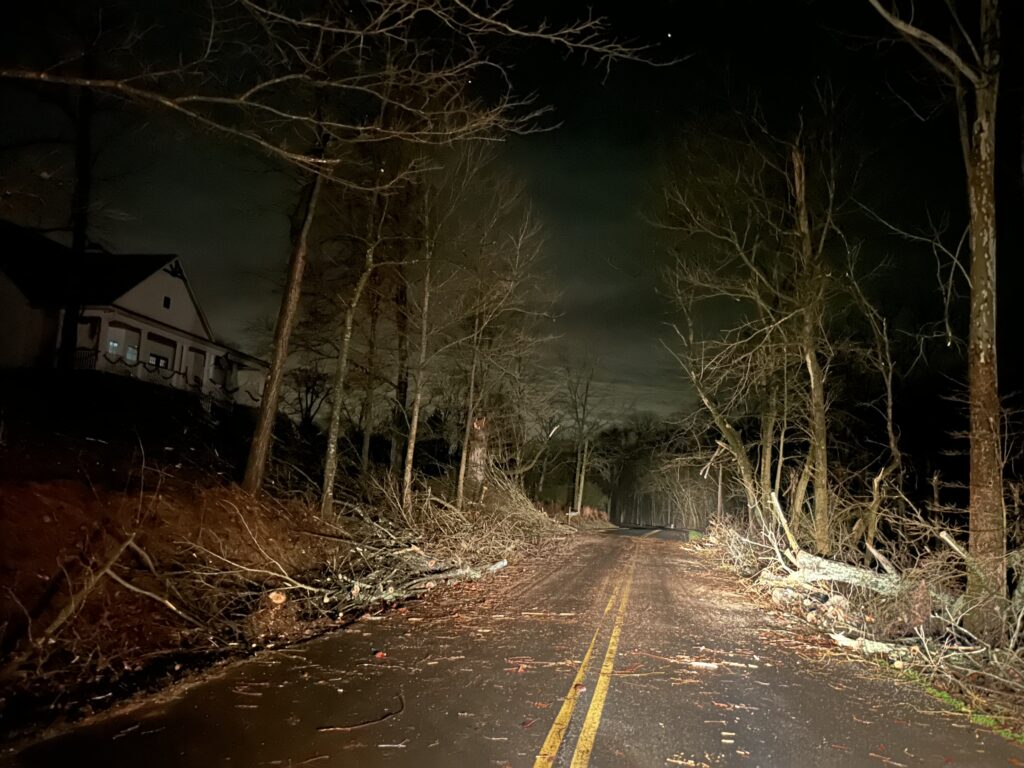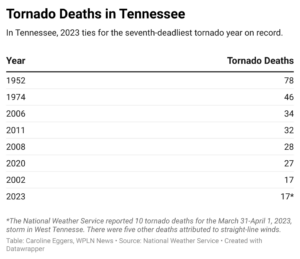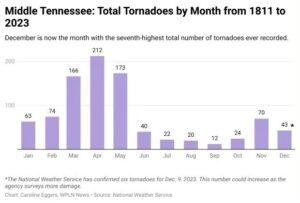
Seventeen people in Tennessee died from tornadoes in 2023, tying it with 2002 as the seventh-deadliest year for tornadoes recorded.
Last weekend, violent twisters flipped cars, blew up a substation and squashed homes. Six people died in Madison and Clarksville at the time. Penny Kaye Scroggins, of Clarksville, passed away a week later from injuries sustained during the tornado.
In the spring, there were 10 deaths during the March 31-April 1 tornado event in West Tennessee. There were also five deaths during the storm from straight-line winds, but the National Weather Service separates fatalities by the specific hazard.
Spring has historically been the season with the most tornadoes in the state, but tornadoes can happen at any time of the year.
December has the 7th-highest total of recorded tornadoes
December is now the month with the seventh-highest total of tornadoes recorded in Middle Tennessee.
Between 1811 and 2020, there were only 16 tornadoes ever recorded during the month of December in Middle Tennessee. Now, there have been at least 43 tornadoes, thanks to clusters in the past two years.
In 2021, the tornado event on Dec. 10-11 had a cluster of 16 tornadoes. That was the fifth-largest tornado outbreak in Middle Tennessee. There were five other tornadoes that month.
On Saturday, at least six tornadoes touched down in Middle Tennessee, though NWS was still surveying damage as of Tuesday. The agency found that the EF-3 tornado in Clarksville carved a path 42 miles long with winds estimated at 150 miles per hour. NWS also found evidence of four EF-2 tornadoes and an EF-1 tornado as part of the outbreak. The tornado that impacted Nashville, Madison, Hendersonville and Gallatin was an EF-2 that traveled 31 miles.
Climate change may increase the threat of winter tornadoes
Winter tornadoes may become more common in Tennessee. New research from Northern Illinois University shows that supercells, the type of thunderstorm that leads to most tornadoes, will likely increase in winter months with additional global warming from fossil fuel burning, deforestation and agriculture.
“This increasing supercell frequency and footprint extent will be clustered in the winter and early spring,” when days are shorter, researchers wrote in an American Meteorological Society article in January. “With supercell risk, human and built-environment exposure, and socioeconomic vulnerabilities projected to rise in the Ozarks, mid-South, and Tennessee valley, the likelihood for more impactful tornado events in these regions is certain for the twenty-first century.”
Tornado science is complex
In the U.S., there has not been an increase in the average annual number of tornadoes, but tornadoes are clustering in greater numbers. There is also evidence that tornado power is increasing and “Tornado Alley” is shifting eastward, according to the Fifth National Climate Assessment, a federal roundup of climate change science.
The environment that all storms happen in has changed from global warming, but scientific understanding varies for different storm types. While climate change is intensifying some weather, like heavy rainfall and extreme heat, it is less clear how the warming world is affecting tornado trends.
Tornadoes have four main ingredients: warm, moist air, wind shear, atmospheric instability and a cold front or air-lifting mechanism.
Both of the recent December tornado outbreaks had warmer-than-average temperatures. In 2021, Memphis and a dozen other cities hit record-high daily temperatures on the first day of the tornado outbreak — Memphis hit 73 degrees. This year, Nashville was 68 degrees on the day of the tornado.
Update: The December 2023 tornadoes caused seven fatalities in Tennessee. The National Weather Service initially reported six deaths, but Scroggins died a week later from injuries sustained during the tornado in Clarksville.


